Surface Modification of PVDF Membranes for Treating Produced Waters by Direct Contact Membrane Distillation
Abstract
1. Introduction
2. Materials and Methods
2.1. Materials
2.2. Characterization of Base Membrane
2.3. Characterization of Produced Water (PW)
2.4. Synthesis of Ionic Liquid Monomer
2.5. Membrane Modification
2.5.1. UV Grafting of Hydrophilic Polymers
2.5.2. Surface Oxidation by KMnO4 and NaOH
2.6. Characterization of Modified Membranes
2.7. Direct Contact Membrane Distillation (DCMD)
2.8. Pretreatment
3. Results and Discussion
3.1. Surface Modification
3.1.1. Hydrophilic Polymer Grafting
3.1.2. Surface Oxidation
3.2. Characterization
3.2.1. FTIR Spectroscopy
3.2.2. Water Contact Angle Measurement
3.3. DCMD Performance
3.4. Membrane Fouling
4. Conclusions
Author Contributions
Acknowledgement
Conflicts of Interest
References
- Ernest, M.; Henry, J.; Meggs, A. Future of The Natural Gas—An Interdisciplinary MIT Study; MIT: Cambridge, MA, USA, 2011; ISBN 9780982800836. [Google Scholar]
- Duong, H.C. Membrane distillation for strategic desalination applications. Ph.D. Thesis, School of Civil, Mining and Environmental Engineering, University of Wollongong, Wollongong, Australia, August 2017. Available online: https://ro.uow.edu.au/theses1/155.
- Badruzzaman, M.; Voutchkov, N.; Weinrich, L.; Jacangelo, J.G. Selection of pretreatment technologies for seawater reverse osmosis plants: A review. Desalination 2019, 449, 78–91. [Google Scholar] [CrossRef]
- Gregory, K.B.; Vidic, R.D.; Dzombak, D.A. Water management challenges associated with the production of shale gas by hydraulic fracturing. Elements 2011, 7, 181–186. [Google Scholar] [CrossRef]
- Termpiyakul, P.; Jiraratananon, R.; Srisurichan, S. Heat and mass transfer characteristics of a direct contact membrane distillation process for desalination. Desalination 2005, 177, 133–141. [Google Scholar] [CrossRef]
- Vidic, R.D.; Brantley, S.L.; Vandenbossche, J.M.; Yoxtheimer, D.; Abad, J.D. Impact of shale gas development on regional water quality. Science 2013, 340, 6134. [Google Scholar] [CrossRef] [PubMed]
- Shaffer, D.L.; Arias Chavez, L.H.; Ben-Sasson, M.; Romero-Vargas Castrillón, S.; Yip, N.Y.; Elimelech, M. Desalination and reuse of high-salinity shale gas produced water: Drivers, technologies, and future directions. Environ. Sci. Technol. 2013, 47, 9569–9583. [Google Scholar] [CrossRef] [PubMed]
- Xu, P.; Drewes, J.E.; Heil, D. Beneficial use of co-produced water through membrane treatment: technical-economic assessment. Desalination 2008, 225, 139–155. [Google Scholar] [CrossRef]
- Munirasu, S.; Haija, M.A.; Banat, F. Use of membrane technology for oil field and refinery produced water treatment - A review. Process Saf. Environ. Prot. 2016, 100, 183–202. [Google Scholar] [CrossRef]
- Taherifar, H.; Rezvantalab, S.; Bahadori, F.; Sadrzadeh Khoei, O. Treatments of reverse osmosis concentrate using natural zeolites. J. Water L. Dev. 2015, 25, 41–46. [Google Scholar] [CrossRef]
- Jiang, C.; Wang, Y.; Zhang, Z.; Xu, T. Electrodialysis of concentrated brine from RO plant to produce coarse salt and freshwater. J. Memb. Sci. 2014, 450, 323–330. [Google Scholar] [CrossRef]
- David, M.; Swaminathan, J.; Guillen-, E.; Arafat, H.A.; Scaling, J.H.L.V.; Link, C. Scaling and fouling in membrane distillation for desalination applications: A review. Desalination 2016, 356, 294–313. [Google Scholar]
- Eykens, L.; De Sitter, K.; Dotremont, C.; Pinoy, L.; Van der Bruggen, B. Membrane synthesis for membrane distillation: A review. Sep. Purif. Technol. 2017, 182, 36–51. [Google Scholar] [CrossRef]
- Lawson, K.W.; Lloyd, D.R. Membrane distillation. J. Memb. Sci. 1997, 124, 1–25. [Google Scholar] [CrossRef]
- Hendren, Z.D.; Brant, J.; Wiesner, M.R. Surface modification of nanostructured ceramic membranes for direct contact membrane distillation. J. Memb. Sci. 2009, 331, 1–10. [Google Scholar] [CrossRef]
- Drioli, E.; Ali, A.; Macedonio, F. Membrane distillation: Recent developments and perspectives. Desalination 2015, 356, 56–84. [Google Scholar] [CrossRef]
- Malmali, M.; Fyfe, P.; Lincicome, D.; Sardari, K.; Wickramasinghe, S.R. Selecting membranes for treating hydraulic fracturing produced waters by membrane distillation. Sep. Sci. Technol. 2017, 52, 266–275. [Google Scholar] [CrossRef]
- Sardari, K.; Fyfe, P.; Wickramasinghe, S.R. Integrated electrocoagulation–Forward osmosis–Membrane distillation for sustainable water recovery from hydraulic fracturing produced water. J. Memb. Sci. 2019, 574, 325–337. [Google Scholar] [CrossRef]
- Deshmukh, A.; Boo, C.; Karanikola, V.; Lin, S.; Straub, A.P.; Tong, T.; Warsinger, D.M.; Elimelech, M. Membrane distillation at the water-energy nexus: Limits, opportunities, and challenges. Energy Environ. Sci. 2018, 11, 1177–1196. [Google Scholar] [CrossRef]
- Boo, C.; Lee, J.; Elimelech, M. Omniphobic Polyvinylidene Fluoride (PVDF) Membrane for Desalination of Shale Gas Produced Water by Membrane Distillation. Environ. Sci. Technol. 2016, 50, 12275–12282. [Google Scholar] [CrossRef] [PubMed]
- Liu, F.; Hashim, N.A.; Liu, Y.; Abed, M.R.M.; Li, K. Progress in the production and modification of PVDF membranes. J. Memb. Sci. 2011, 375, 1–27. [Google Scholar] [CrossRef]
- Wei, X.; Zhao, B.; Li, X.M.; Wang, Z.; He, B.Q.; He, T.; Jiang, B. CF4 plasma surface modification of asymmetric hydrophilic polyethersulfone membranes for direct contact membrane distillation. J. Memb. Sci. 2012, 407–408, 164–175. [Google Scholar] [CrossRef]
- Dizon, G.V.; Venault, A. Direct in-situ modification of PVDF membranes with a zwitterionic copolymer to form bi-continuous and fouling resistant membranes. J. Memb. Sci. 2018, 550, 45–58. [Google Scholar] [CrossRef]
- Rahimpour, A.; Madaeni, S.S.; Zereshki, S.; Mansourpanah, Y. Preparation and characterization of modified nano-porous PVDF membrane with high antifouling property using UV photo-grafting. Appl. Surf. Sci. 2009, 255, 7455–7461. [Google Scholar] [CrossRef]
- Sardari, K.; Askegaard, J.; Chiao, Y.H.; Darvishmanesh, S.; Kamaz, M.; Wickramasinghe, S.R. Electrocoagulation followed by ultrafiltration for treating poultry processing wastewater. J. Environ. Chem. Eng. 2018, 6, 4937–4944. [Google Scholar] [CrossRef]
- Sardari, K.; Fyfe, P.; Lincicome, D.; Wickramasinghe, S.R. Aluminum electrocoagulation followed by forward osmosis for treating hydraulic fracturing produced waters. Desalination 2018, 428, 172–181. [Google Scholar] [CrossRef]
- Malmali, M.; Askegaard, J.; Sardari, K.; Eswaranandam, S.; Sengupta, A.; Wickramasinghe, S.R. Evaluation of ultrafiltration membranes for treating poultry processing wastewater. J. Water Process Eng. 2018, 22, 218–226. [Google Scholar] [CrossRef]
- Sardari, K.; Fyfe, P.; Lincicome, D.; Wickramasinghe, S.R. Combined electrocoagulation and membrane distillation for treating high salinity produced waters. J. Memb. Sci. 2018, 564, 82–96. [Google Scholar] [CrossRef]
- Rabuni, M.; Nik Sulaiman, N.; Aroua, K.; Awanis Hashim, N. Effects of Alkaline Environments at Mild Conditions on the Stability of PVDF Membrane: An Experimental Study. Ind. Eng. Chem. Res. 1976, 9, 341–342. [Google Scholar] [CrossRef]
- Xu, Z.; Li, L.; Wu, F.; Tan, S.; Zhang, Z. The application of the modified PVDF ultrafiltration membranes in further purification of Ginkgo biloba extraction. J. Memb. Sci. 2005, 255, 125–131. [Google Scholar] [CrossRef]
- Sethunga, G.S.M.D.P.; Rongwong, W.; Wang, R.; Bae, T.H. Optimization of hydrophobic modification parameters of microporous polyvinylidene fluoride hollow-fiber membrane for biogas recovery from anaerobic membrane bioreactor effluent. J. Memb. Sci. 2018, 548, 510–518. [Google Scholar] [CrossRef]
- Awanis Hashim, N.; Liu, Y.; Li, K. Stability of PVDF hollow fibre membranes in sodium hydroxide aqueous solution. Chem. Eng. Sci. 2011, 66, 1565–1575. [Google Scholar] [CrossRef]
- Zheng, Z.; Gu, Z.; Huo, R.; Luo, Z. Fabrication of Self-Cleaning Poly(vinylidene fluoride) Membrane with Micro/Nanoscaled Two-Tier Roughness. Appl. Polym. Sci. 2011, 122, 1268–1274. [Google Scholar] [CrossRef]
- Wang, S.; Li, J.; Suo, J.; Luo, T. Surface modification of porous poly(tetrafluoraethylene) film by a simple chemical oxidation treatment. Appl. Surf. Sci. 2010, 256, 2293–2298. [Google Scholar] [CrossRef]
- Metcalf, E.; Eddy, H. Wastewater Engineering: Treatment and Reuse, 5th ed.; McGraw-Hill: New York, NY, USA, 2003; ISBN 0-07-041878-0. [Google Scholar]
- Mondal, S.; Wickramasinghe, S.R. Produced water treatment by nanofiltration and reverse osmosis membranes. J. Memb. Sci. 2008, 322, 162–170. [Google Scholar] [CrossRef]
- Li, J.H.; Li, M.Z.; Miao, J.; Wang, J.B.; Shao, X.S.; Zhang, Q.Q. Improved surface property of PVDF membrane with amphiphilic zwitterionic copolymer as membrane additive. Appl. Surf. Sci. 2012, 258, 6398–6405. [Google Scholar] [CrossRef]
- Jebur, M.; Sengupta, A.; Chiao, Y.H.; Kamaz, M.; Qian, X.; Wickramasinghe, R. Pi electron cloud mediated separation of aromatics using supported ionic liquid (SIL) membrane having antibacterial activity. J. Memb. Sci. 2018, 556, 1–11. [Google Scholar] [CrossRef]
- Huang, Y.-X.; Wang, Z.; Jin, J.; Lin, S. Novel Janus membrane for membrane distillation with simultaneous fouling and wetting resistance. Environ. Sci. Technol. 2017, 51, 13304–13310. [Google Scholar] [CrossRef] [PubMed]
- Eykens, L.; De Sitter, K.; Dotremont, C.; Pinoy, L.; Van der Bruggen, B. How to Optimize the Membrane Properties for Membrane Distillation: A Review, Ind. Eng. Chem. Res. 2016, 55, 9333–9343. [Google Scholar] [CrossRef]
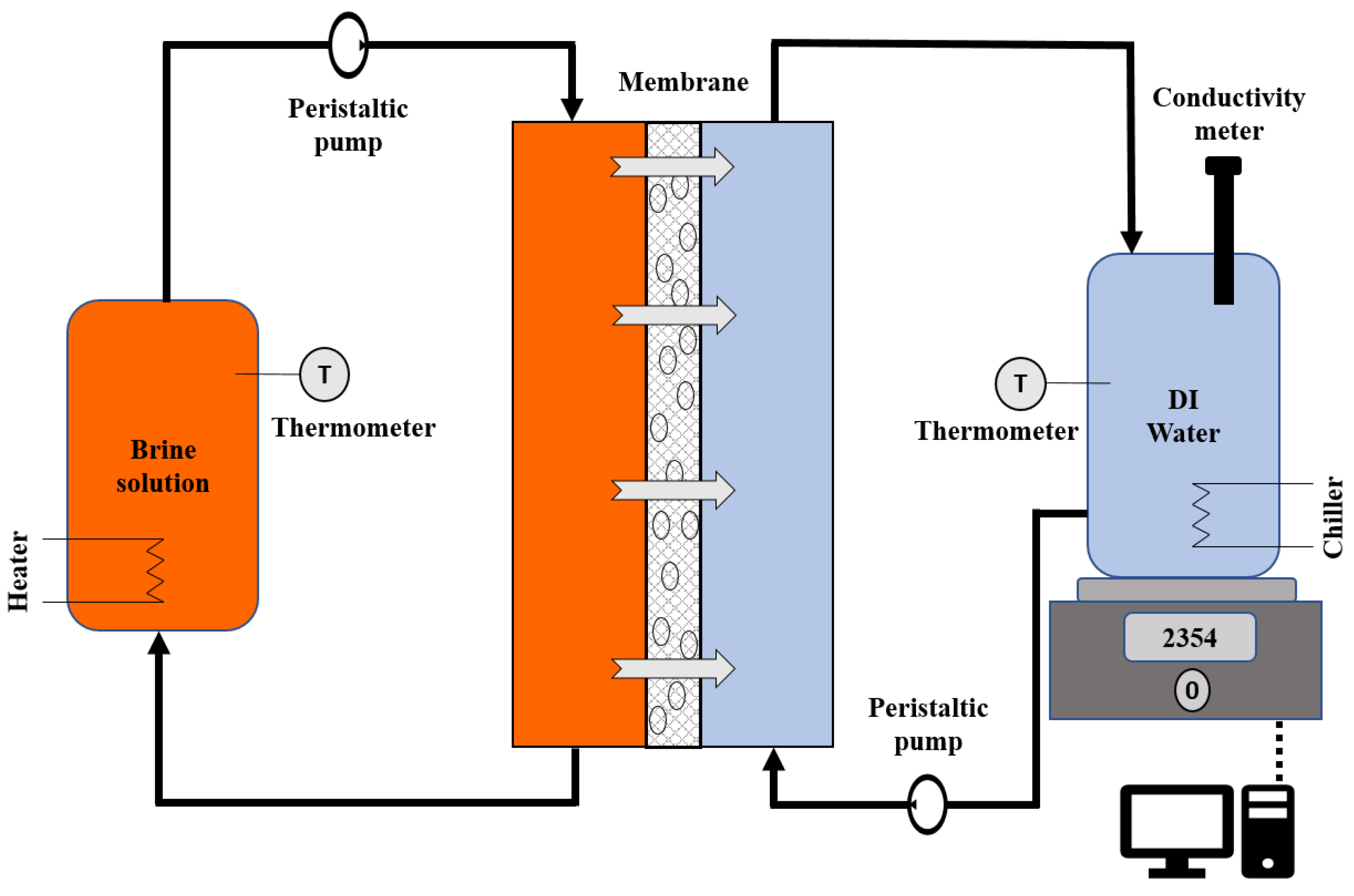
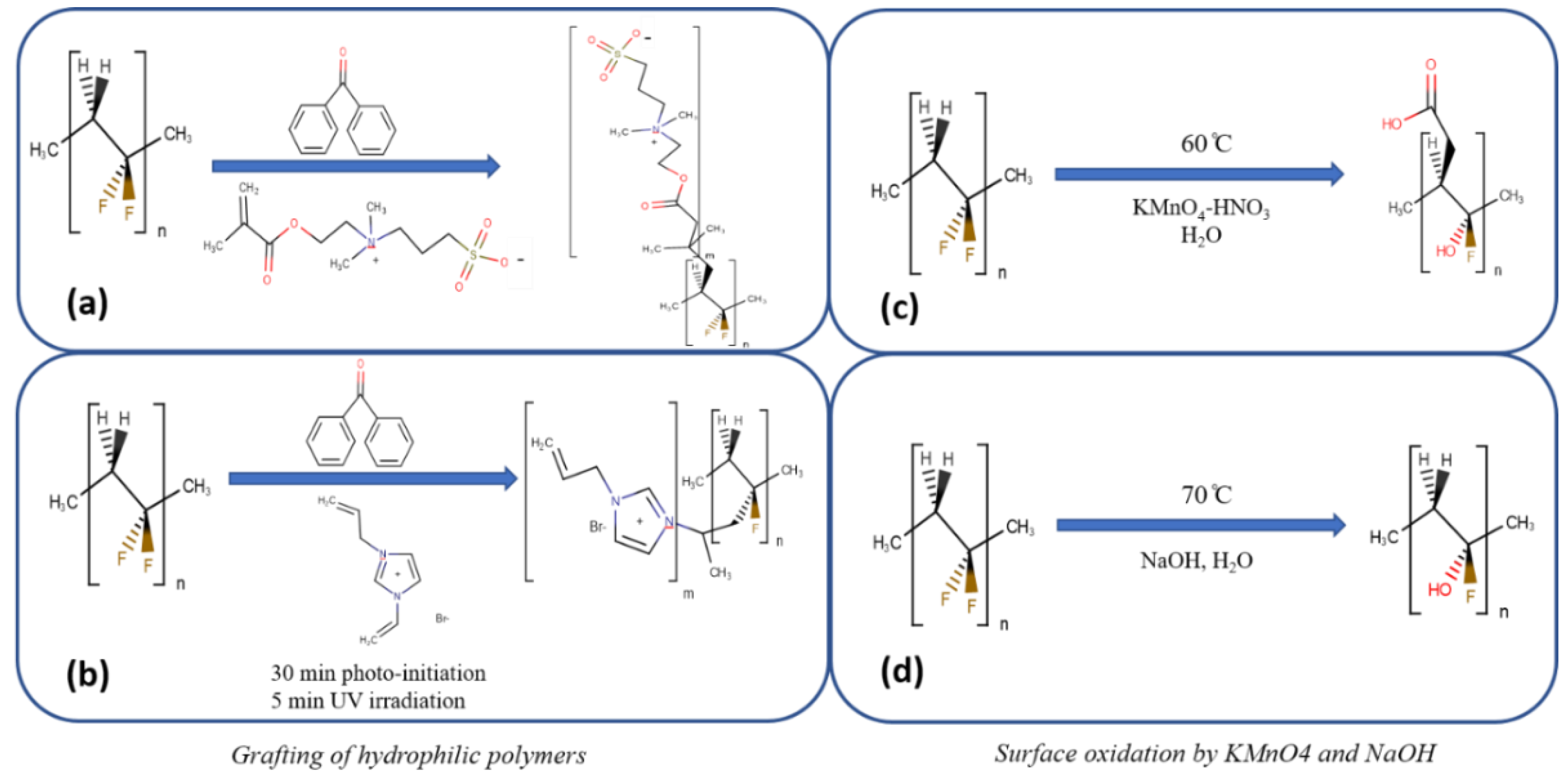
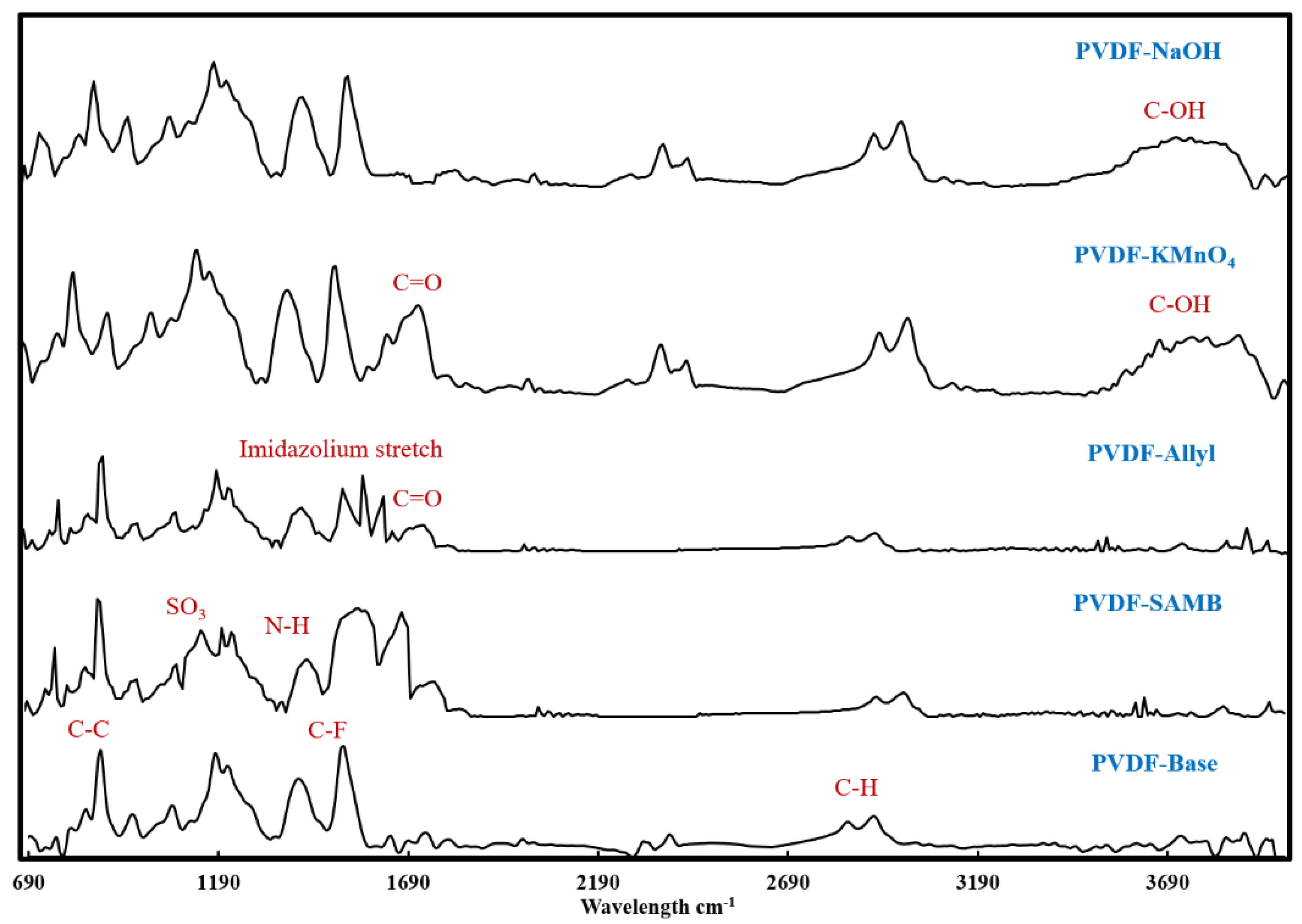

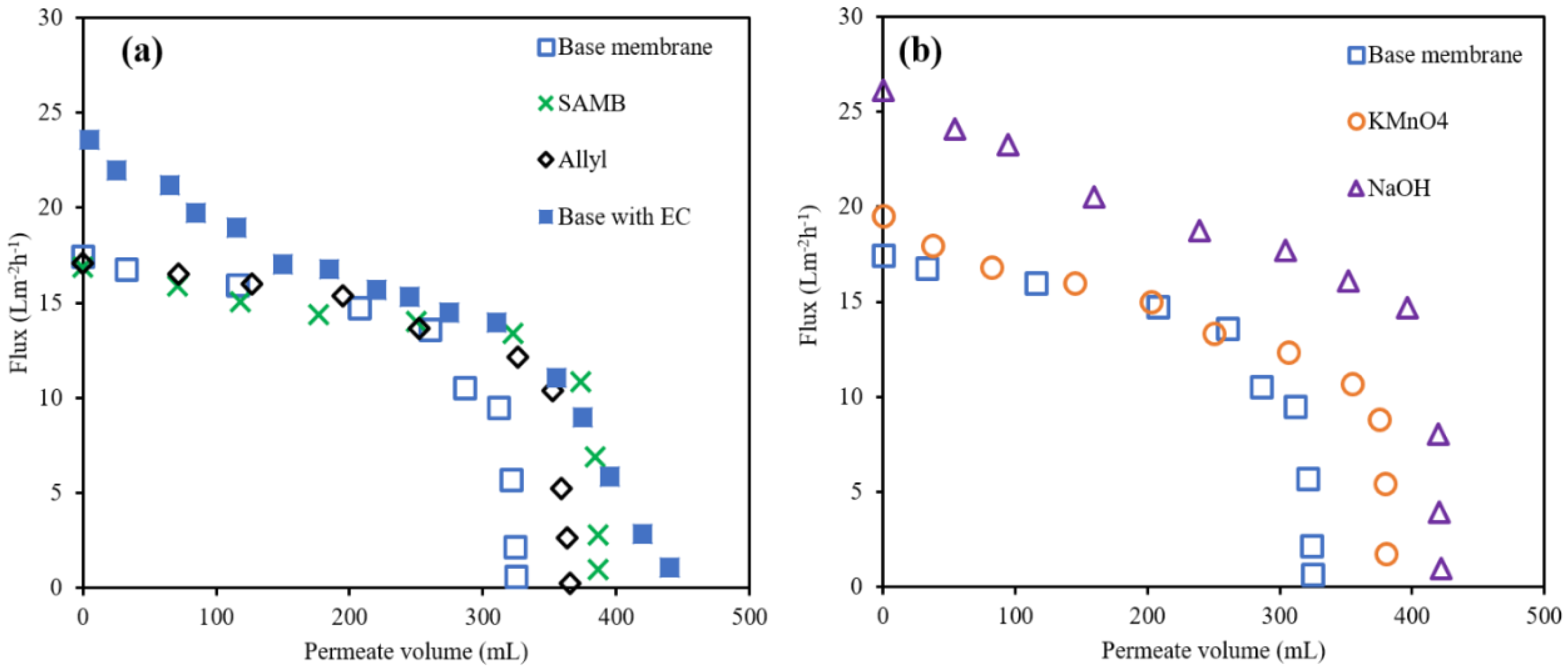
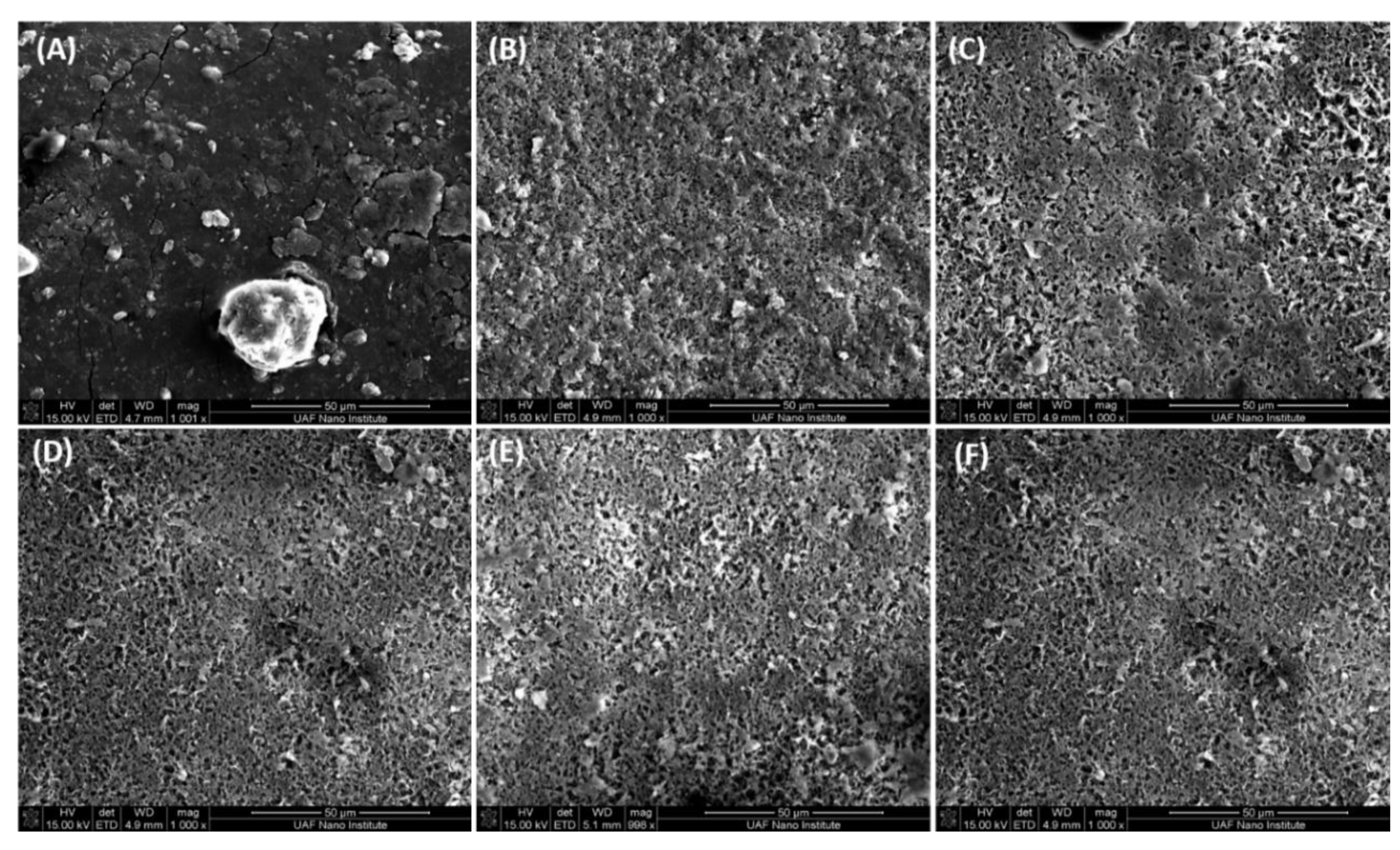
| Membrane | Nominal Pore Size (μm) | Porosity (ε) | Thickness (δ) (μm) | dmean Gas Permeation (μm) | Liquid Entry Pressure LEP (KPa) | Contact Angle | Tortuosity (τ) |
|---|---|---|---|---|---|---|---|
| PVDF | 0.2 | 0.69 | 110 | 0.22 | 400 | 145° ± 2 | 2.01 |
| Parameter | Concentration (ppm) |
|---|---|
| Calcium | 24052 |
| Magnesium | 2463 |
| Sodium | 50379 |
| Chloride | 128786 |
| Sulfate | 8.6 |
| TOC | 181 |
| TSS | 1460 |
| TN | 15 |
| TDS | 202130 |
| Turbidity | 273 NTU |
| Element (at. %) | Base Membrane | After DCMD | |||||
|---|---|---|---|---|---|---|---|
| Base | Base with EC | SAMB | Allyl | KMnO4 | NaOH | ||
| C | 41.3 | 32.7 | 35.4 | 40.3 | 38.9 | 37.7 | 35.8 |
| F | 56.1 | 23.4 | 24.7 | 19.1 | 18.4 | 13.3 | 12.1 |
| O | - | 10.4 | 3.1 | 4.6 | 2.6 | 19.8 | 21.4 |
| N | - | 5.2 | 1.9 | 4.8 | 5.9 | 1.4 | 0.8 |
| Au | 2.6 | 4.6 | 5.2 | 4.1 | 7.3 | 4.9 | 5.2 |
| Na | - | 6.3 | 7.4 | 6.8 | 7.3 | 7.1 | 8.1 |
| Cl | - | 6.9 | 10.5 | 8.5 | 8.7 | 6.7 | 7.6 |
| Ca | - | 8.4 | 7.4 | 9.3 | 8.1 | 5.6 | 6.4 |
| Mg | - | 2.1 | 4.4 | 2.5 | 2.8 | 3.5 | 2.6 |
© 2019 by the authors. Licensee MDPI, Basel, Switzerland. This article is an open access article distributed under the terms and conditions of the Creative Commons Attribution (CC BY) license (http://creativecommons.org/licenses/by/4.0/).
Share and Cite
Kamaz, M.; Sengupta, A.; Gutierrez, A.; Chiao, Y.-H.; Wickramasinghe, R. Surface Modification of PVDF Membranes for Treating Produced Waters by Direct Contact Membrane Distillation. Int. J. Environ. Res. Public Health 2019, 16, 685. https://doi.org/10.3390/ijerph16050685
Kamaz M, Sengupta A, Gutierrez A, Chiao Y-H, Wickramasinghe R. Surface Modification of PVDF Membranes for Treating Produced Waters by Direct Contact Membrane Distillation. International Journal of Environmental Research and Public Health. 2019; 16(5):685. https://doi.org/10.3390/ijerph16050685
Chicago/Turabian StyleKamaz, Mohanad, Arijit Sengupta, Ashley Gutierrez, Yu-Hsuan Chiao, and Ranil Wickramasinghe. 2019. "Surface Modification of PVDF Membranes for Treating Produced Waters by Direct Contact Membrane Distillation" International Journal of Environmental Research and Public Health 16, no. 5: 685. https://doi.org/10.3390/ijerph16050685
APA StyleKamaz, M., Sengupta, A., Gutierrez, A., Chiao, Y.-H., & Wickramasinghe, R. (2019). Surface Modification of PVDF Membranes for Treating Produced Waters by Direct Contact Membrane Distillation. International Journal of Environmental Research and Public Health, 16(5), 685. https://doi.org/10.3390/ijerph16050685






